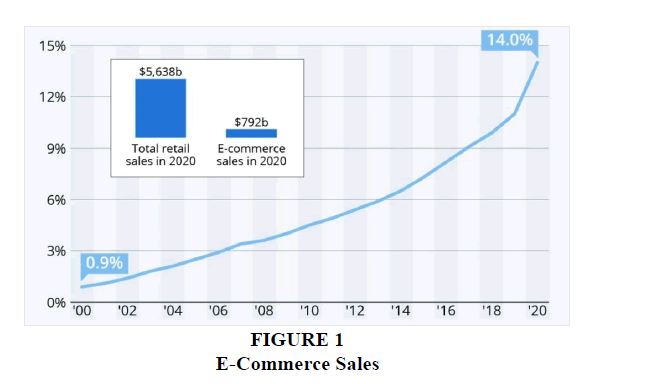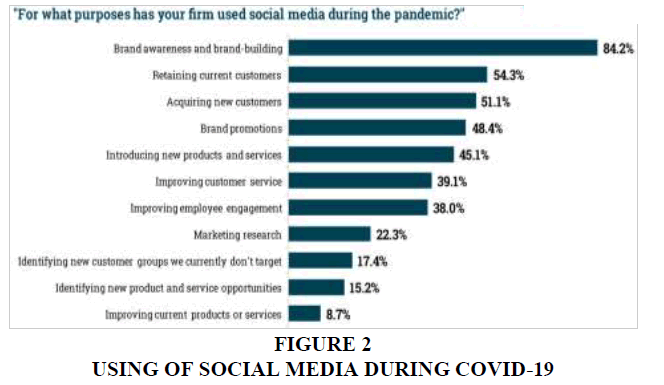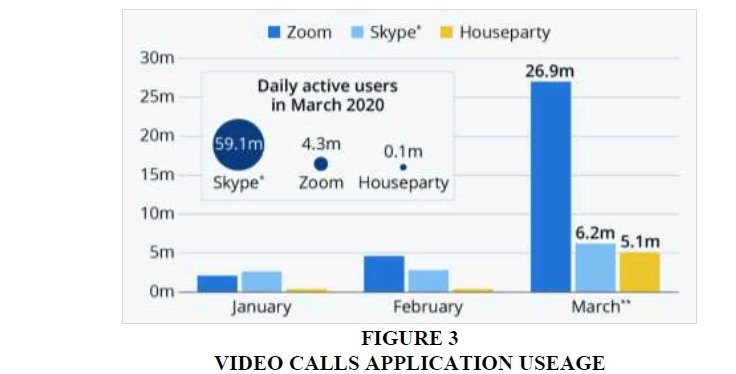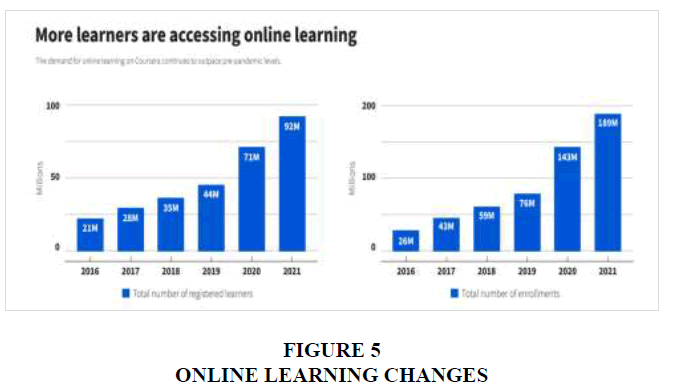Research Article: 2023 Vol: 26 Issue: 2S
Influence of the Covid-19 Pandemic on the Digital Transformation
Abdulaziz Aldarsoni, Imam Abdulrahman Bin Faisal University
Mead AlDossary, Imam Abdulrahman Bin Faisal University
Mohammed Alghamdi, Imam Abdulrahman Bin Faisal University
Faisal Alghamdi, Imam Abdulrahman Bin Faisal University
Yahya Alghamdi, Imam Abdulrahman Bin Faisal University
Mahmood Maqsood, University of Bahrain
Hoda Mahmood Abalsmh, Imam Abdulrahman Bin Faisal University
Ibrahim Tawfeeq Alsedrah, Imam Abdulrahman Bin Faisal University
Zahra Afridi, Imam Abdulrahman Bin Faisal University
Citation Information: Aldarsoni, A., Aldossary, M., Alghamdi, M., Alghamdi, F., Alghamdi, Y., Maqsood, M., Abalsmh, H.M., Alsedrah, I.T., & Afridi, Z. (2023). Influence of the Covid-19 Pandemic on the Digital Transformation. Journal of Entrepreneurship Education, 26(S2),1-10.
Abstract
The Covid-19 pandemic affected many sectors leading to various challenges. Governments introduced measures that forced people to stay indoors, making it hard to perform their duties. Schools were also forced to close to avoid the spread of the virus. The challenges experienced during the pandemic led to digital transformation in various areas to guarantee smooth operations were experienced. For example, businesses learned new ways of interacting with consumers and selling products. Online business operations increased, whereby consumers would purchase products online and have their goods shipped to them. Social media use also increased due to the pandemic, where companies and individuals used the platforms to share information. The health sector also introduced new ways of providing care through telehealth. Patients learned that they could consult doctors online without necessarily vesting the hospitals. The education sector also introduced digital learning in many institutions after the governments ordered learning institutions to close. Thus, various aspects show the influence of the Covid-19 pandemic on digital transformation.
Keywords
Digital, Online, Pandemic, Business, Covid-19, Transformation, Organizations, Companies.
Introduction
For many years, the political, economic, and societal realms have been involved in digital transformation. However, the Covid-19 pandemic has affected many people transforming different areas. Individuals and organizations have been forced to adapt to new ways of life due to the pandemic. Many countries have introduced measures that prevent crowding. This has led to institutions implementing new ways of communicating and offering services to clients. Modern technology has also been of great significance during the pandemic as it has helped companies to exercise new technological approaches. For instance, many companies have switched to online selling, whereby customers can view and purchase goods online. Social media marketing has also increased due to the virus, where companies use different platforms for advertising their products. Online learning is another aspect the pandemic has steered to guarantee that learners can continue learning using digital media. Therefore, various issues can be analyzed to show how the Covid-19 pandemic has influenced digital transformation.
Objective and Limitations
Objective of the Research
In this paper, we seek to conduct a big-picture analysis and common issues of Covid-19 and to add to the existing literature in the field of business and management and Seek out the influence of the pandemic in digital business.
Limitations of the Research
This research is not without its limitations. Since our search strategy was in favor of the high-tier academic well-cited papers, a certain degree of selection bias can be considered as the first limitation of our work. Future research should apply and combine multiple databases, the time frame also excluded some recent publications. future study can extend the timeframe to capture more recent studies as the field of Covid19-related research in business and management continues to grow.
Research Methodology
The report will use various articles and reports to acquire credible results on how digital transformation has been influenced by Covid -19. The sources will provide credible data that will be analyzed before concluding these influences. The information regarding companies in different sectors will be analyzed to determine the aspects that have forced the organizations to shift to digital transformation. The data collection of the research paper will be from various sources that emphasize on the digital transformation during the spread of COVID-19 and what was the reaction of the business owners in such pandamic. It will also highlights the new strarigies that has been approached in order to survive and avoide the major lost. Furthermore, some quantitiaves data will be measured to support the research objective, such as, the effect of COVID-19 pandamic on the increase of the E-commerce, the increase of the Telehealth visit in the health sector in the period of COVID-19 and the huge increase of the enrollment and registration of the online learning institutaion in the education sector.
Critical Review
Online Buying and Selling
One of the significant influences of Covid-19 on digital transformation involves online buying and selling. Although many individuals and companies were practicing online buying and selling before the pandemic, the Covid-19 virus has increased online buying as many companies have introduced ways that customers can order products and services without necessarily having to visit the companies. The measures implemented by countries to encourage social distancing to mitigate the spread of the virus have created opportunities for companies to introduce online buying. Consumers have adapted to the transformation and are purchasing their products online (Savic, 2020). The improved technology makes it easy for individuals to access companies’ websites and buy their products. The products can be shipped, and consumers can pick them up at a particular branch or have them dropped at their doorstep. The approach has been of great significance in minimizing company crowding, and many countries have encouraged the public to use the method during the pandemic. For instance, companies in the food and beverage sector have embraced the approach where consumers shop online, and their products are delivered to them (Indriastuti & Fuad, 2020). An increased number of companies offering delivery services have also been recorded during the pandemic to make it easy for people to buy products online. Shipping companies have also recorded an increase in the number of people using the technique to purchase products from the companies to ensure they get their products on time without traveling to the manufacturing organizations. The digital transformation led to companies introducing procedures on their websites where clients can contact customer care agents and enquire about the products and services and how to purchase them conveniently (Indriastuti & Fuad, 2020). Tracking goods purchased and shipped is also easy due to modern technology that allows the client to use mobile applications to monitor the progress of their purchased goods. Improved internet infrastructure in many regions makes it easy for users to log in to their devices, access the goods and services companies offer, and easily purchase them irrespective of their locations. Therefore, technology has also made it easy for people to embrace digital transformation, leading to online buying and selling.
Governments have also encouraged companies to sell their products online to avoid losses and ensure that consumers can access them. The increased online sales during the pandemic have been influenced by the need for people to observe safety measures introduced by the government. Governments have encouraged companies to shift to online sales where they can allow consumers to access products. Although some companies were forced to shut down during the pandemic due to the virus, others sold their products online and offered lower-cost shipping services. This encouraged buyers to adapt to new changes and learn how to purchase their goods digitally. The companies have attracted consumers across the continents since buying products online is quick and less exhausting (Fernando et al., 2020). Many companies experienced a decline in sales during the first days of the pandemic. However, the companies recorded an increase in sales after online sales. The pandemic impacted consumers and suppliers, and online sales played a significant role in helping suppliers sell their products. Thus, governments also influenced people to practice online selling to mitigate the spread of the virus, an approach that led to digital transformation. The graph below shows the increase in online buying due to the pandemic Figure 1.
Social Media Marketing
Digital marketing is another aspect showing the influence of Covid-19 on digital transformation. Covid-19 forced companies to use various social media platforms for advertising their products and services. The increased use of social media during the pandemic allowed companies to market their products on social media platforms such as Facebook, Twitter, and Instagram (Mason et al., 2021). Companies used social media marketing before the pandemic. Still, the increased social distancing measures led to the need for companies to motivate clients to use social media to enquire about products and services. Many clients have adapted to social media marketing and log in to the platforms to access product and service information before purchasing them online.
The study above showed Figure 2 the difference purposes of usning the social meadia platforms during the pandamic of COVID-19, which showed that number one reasone is to build a brand awareness then cane second to retain and aquire customers.
Increased Pace of Deployment of Digital Transformation Systems
The pandemic has increased the need for companies to introduce approaches that support working from home. After learning that many workers would be working remotely, IT managers and technical staff increased the speed of deployment of digital transformation resources. For example, advanced e-commerce platforms and supply chain systems were embraced to improve the firm’s ability to deploy customer-friendly applications (Fernando et al., 2020). Organizations developed apps to ensure operations in companies would be excised by workers remotely, which also significantly impacts digital transformation.
Increased use of Customer-friendly Apps to Meet Customer Needs
Friendly apps to meet consumer expectations have been designed to increase sales during the pandemic. In this case, companies recognized that many customers would stay indoors due to pandemic quarantine requirements. Business leaders had to ensure their clients had the best possible experience dealing with the firms (Fernando et al., 2020). Hence it was vital for firms to deploy customer-friendly systems and applications that are the symbol of successful digital business models. Additionally, businesses focused on real-time access to customer-focused applications because customers increasingly used mobile devices.
Increased use of Self-service Apps
The covid-19 pandemic has increased the need for people to access data and explore the information provided before making any conclusion. This was exercised since social distancing introduced did not allow consumers to overcrowd companies consulting customer care services. The deployment of applications that improve access to self-service resources is one of the digital transformations influenced by the pandemic (Kim, 2020). The approach was introduced to provide a top-notch customer experience whereby customers can perform more activities on a company’s website. For example, self-service apps allow clients to shop, compare products and prices, and complete transactions. The apps are also beneficial to companies since they can gain valuable data from customer self-service activities, where the data can be examined to determine buying preferences and other metrics. After data analysis, organizations can use the findings to manufacture products that meet consumer demands. Many companies have performed this during the pandemic, showing that the pandemic has greatly influenced digital transformation as many organizations have introduced self-service apps.
More use of Advanced E-commerce Platforms
E-commerce in business has increased during the pandemic, with companies inventing ways that consumers can access the needed products. The introduction of e-commerce in the industry has primarily allowed companies to present what they offer on their platforms and engage with consumers to deliver their products. The increased demand for various goods impacted supply chains in companies, and organizations realized that using ecommerce platforms was a solution to modify the supply chains as required to accommodate the demand shifts (Bhatti et al., 2020). For instance, organizations have ensured that they can improve their logistics to deliver goods to clients within a short period efficiently. The improvement involves using technology to communicate with clients and inform them about the processing of purchases and the movement of the products to their destinations. Consumers have learned the importance of ecommerce during the pandemic, increasing the number of people accessing the websites in companies and using them to buy the products. The approach has also been encouraged by governments where social distancing has been achieved to limit the virus’s spread.
Online Meetings
With many workers in organizations working remotely, online meetings were introduced. Companies were forced to exercise online sessions to avoid congestion. Governments encouraged organizations to develop strategies to hold online meetings to mitigate the virus’s spread. Zoom meetings have become common during the pandemic, and workers have adapted to these changes (Rangarajan et al., 2021). The digital transformation from physical sessions has enabled employees to interact with other workers using zoom and discuss various company issues. The approach has been practical during the pandemic, where companies have implemented ways to increase their sales despite facing challenges due to the virus. Not many people were conversant in using online meetings, but the pandemic has influenced the digital transformation where individuals have learned the importance of utilizing modern technology such as zoom meetings. Working from home requires individuals to interact with others online to share crucial information regarding business procedures. The increased government measures requiring c companies to practice social distancing forced more workers to work from home and use online meetings to interact with workmates. Therefore, increased online sessions have been experienced during the pandemic, a form of digital transformation influenced by the pandemic.
The above chart Figure 3, showed the sharp increase into the use of the video calls applications, as during the start of the pandamic in March 2020, we had a stronge increase in the user of the all applications.
Digital Transformation in Health Sector
Digital transformation in healthcare has been influenced by the pandemic, with new approaches involving the use of technology being enhanced. Access to medical care during the pandemic has been developed to guarantee that people can acquire healthcare services quickly. The pandemic introduced measures that limited people’s easy access to healthcare facilities. Thus, healthcare organizations introduced ways to offer medical services to patients in various regions. The implementation of teleconsultation has increased rapidly due to the pandemic as people are encouraged to seek medical services online. The approach has led to the growth of online platforms to accommodate patient’s needs and improve patient outcomes. The World Health Organization encouraged healthcare institutions to use online platforms to reach out to people who cannot access the facilities (Doraiswamy et al., 2020). Government restrictions forced people to adapt to new technology where they would consult their doctors using online platforms. This is a significant attribute steered by the pandemic since many patients are new to teleconsultation.
Innovative technology in healthcare during the pandemic also encouraged individuals to learn about e-Health. E-Health is the use of information and communication technology to improve patient outcomes and healthcare services. Telemedicine, smartphone apps, and wearable sensors are involved in e-Health and have increased during the pandemic (Doraiswamy et al., 2020). Digital transformation has been encouraged, and people can monitor their health using digital devices. For instance, the use of wearable sensors such as smart watches has increased during the pandemic, with people using gadgets to monitor their health. People have learned the importance of using devices to monitor their blood, oxygen, temperature, and heart rate levels. High temperatures and difficulties in breathing are some symptoms of being infected with the virus. Therefore, healthcare practitioners have encouraged people to use the devices to ensure they can record body changes and seek medical assistance early. Companies such as FitBit have recorded demand for smart watches during the pandemic since people learned the importance of using the products to improve their health.
Telemedicine in healthcare involves using technology to provide healthcare services to patients. Digital transmission in healthcare has increased telehealth, whereby healthcare providers have primarily focused on providing care to the public without an in-person office visit (Garfan et al., 2021). The pandemic has influenced the approach due to the increased demand for social distancing and travel bans. Healthcare providers have encouraged patients to shift to telehealth to avoid congestion in healthcare facilities, which could spread the virus. Many people have utilized the approach for years, but it increased during the pandemic. Additionally, some countries implemented travel bans where people seeking medical services in other regions were advised to acquire telehealth. In this case, patients would receive services online by communicating with their healthcare providers using their phones, tablet, or computers. The technique allowed people to consult their doctors and learn ways they would improve their health. Although the method may not be more convenient than in-person visits to healthcare facilities, it has significantly improved community health during the pandemic. Some inpatients require close monitoring, and telehealth has helped such individuals acquire healthcare services online during the pandemic. Many healthcare organizations have also encouraged workers to embrace and inform patients about telemedicine to ensure care is provided o patients in different regions (Isautier et al., 2020). Telehealth is essential in the prevention of infectious illnesses. Therefore, it has been encouraged to prevent the spread of Covid-19, where doctors use telehealth appointments to prescreen patients for possible contagious diseases. The technique was also promoted since it saves time and is less exhaustive because patients are not required to present themselves to healthcare facilities. Hence, telehealth is one of the significant issues influenced by the Covid-19 pandemic’s influence on digital transformation in the healthcare sector. The graph below shows the rise in telehealth after the Covid-19 outbreak Figure 4.
Online Learning
The covid-19 pandemic primarily affected the academic sector, whereby schools were forced to close to avoid spreading the virus. Learners had to stop classroom lessons as required by the government. The approach affected many students and instructors as they needed to find ways of resuming o learning. The introduction of online classes during the pandemic was one of the methods that many learning institutions practiced to continue with academic activities. Governments also encouraged learners to adapt to the inevitable changes since the virus was unpredictable and schools were unprepared for the pandemic. In this case, the digital transformation to online learning was encouraged, and learners would attend classes online (Irawan et al., 2020). Although the approach had some challenges in some regions with poor internet infrastructure, it allowed learners to continue their education. Teachers encouraged learners to acquire laptops and tablets to join online classes avoiding lengthy stays at home before resuming regular courses.
Online discussions were also performed since schools were closed, leading to students and teachers adapting to the digital transformation. Although teachers and students faced challenges during the first days of digital education, many have claimed that the shift has improved their learning skills, and they are willing to continue learning online in the future (Bahasoan et al., 2020). After the first stage of the pandemic, national governments focused on guaranteeing that students would continue with their academic year, as organizations claimed that online education would be the best option for academic year continuity. The online classes allow teachers to teach via zoom meetings and test their students online (Bahasoan et al., 2020). The experience has also encouraged governments to work with instructors to improve education by motivating teachers to practice online education to help people from various regions join online classes. The transformation has inspired people to join online courses where they can learn while in their home countries without traveling to physical institutions.
Social media has also been used in education during the pandemic, with teachers encouraging learners to join social media platforms for learning purposes. Many people in the modern world are using social media, and these platforms in education increased during the pandemic. The introduction of online learning in many instructions during the pandemic has revealed the importance of social media learning, whereby many students have joined various learning groups (Mukhtar et al., 2020). For instance, WhatsApp is one of the social media platforms many students have used during the pandemic to interact and learn with others. Instructors have encouraged platform discussions by motivating students to join and learn with other learners (Mukhtar et al., 2020). Teachers have used social media platforms to create learning groups where they can give assignments and allow students to research and present their findings. Therefore, social media learning increased during the pandemic, enabling people to learn the importance of digital education. The graph below shows the trend in online learning, whereby an increase can be noted during the pandemic Figure 5.
Social media has also been used in education during the pandemic, with teachers encouraging learners to join social media platforms for learning purposes. Many people in the modern world are using social media, and these platforms in education increased during the pandemic. The introduction of online learning in many instructions during the pandemic has revealed the importance of social media learning, whereby many students have joined various learning groups (Mukhtar et al., 2020). For instance, WhatsApp is one of the social media platforms many students have used during the pandemic to interact and learn with others. Instructors have encouraged platform discussions by motivating students to join and learn with other learners (Mukhtar et al., 2020). Teachers have used social media platforms to create learning groups where they can give assignments and allow students to research and present their findings. Therefore, social media learning increased during the pandemic, enabling people to learn the importance of digital education. The graph below shows the trend in online learning, whereby an increase can be noted during the pandemic Figure 5.
Recommendation
Thus, organizations should have a team that focuses on improving digital transformation and analyzing the changes in the digital world. Additionally, companies should encourage workers to learn more about technology to guarantee that they can utilize it incase wars and epidemics are encountered in future.
Acknowledgement
The researchers would like to thank Imam Abdulrahman Bin Faisal University, and Dr. Maqsood Mahmud Mahmud Khan for the guidance and encorugment in finishing this research.
References
Bahasoan, A.N., Ayuandiani, W., Mukhram, M., & Rahmat, A. (2020). Effectiveness of online learning in pandemic COVID-19.International Journal of Science, Technology & Management,1(2),100-106.
Bhatti, A., Akram, H., Basit, H.M., Khan, A.U., Raza, S.M., & Naqvi, M.B. (2020). E-commerce trends during COVID-19 Pandemic.International Journal of Future Generation Communication and Networking,13(2), 1449-1452.
Doraiswamy, S., Abraham, A., Mamtani, R., & Cheema, S. (2020). Use of telehealth during the COVID-19 pandemic: scoping review.Journal of Medical Internet Research,22(12), e24087.
Fernando, E., Surjandy, S., Meyliana, M., Wijadja, H.A., Hidayat, D., Kusumaningtyas, A.W., & Heryatno, R. (2020). Factors influencing the intention to use technology services to implement self-service technology case study: Situation pandemic Covid-19.Advances in Science, Technology and Engineering Systems Journal,5(5), 342-347.
Garfan, S., Alamoodi, A.H., Zaidan, B.B., Al-Zobbi, M., Hamid, R.A., Alwan, J.K., & Momani, F. (2021). Telehealth utilization during the Covid-19 pandemic: A systematic review.Computers in Biology and Medicine,138, 104878.
Indexed at, Google Scholar, Cross Ref
Indriastuti, M., & Fuad, K. (2020 ). Impact of covid-19 on digital transformation and sustainability in small and medium enterprises (smes): A conceptual framework. InConference on Complex, Intelligent, and Software Intensive Systems, 471-476.
Irawan, A.W., Dwisona, D., & Lestari, M. (2020). Psychological impacts of students on online learning during the pandemic COVID-19.Journal of Guidance and Counseling,7(1), 53-60.
Isautier, J.M., Copp, T., Ayre, J., Cvejic, E., Meyerowitz-Katz, G., Batcup, C., & McCaffery, K.J. (2020). People’s experiences and satisfaction with telehealth during the COVID-19 pandemic in Australia: a cross-sectional survey study.Journal of Medical Internet Research,22(12), e24531.
Indexed at, Google Scholar, Cross Ref
Kim, R.Y. (2020). The impact of COVID-19 on consumers: Preparing for digital sales.IEEE Engineering Management Review,48(3), 212-218.
Indexed at, Google Scholar, Cross Ref
Mason, A.N., Narcum, J., & Mason, K. (2021). Social media marketing gains importance after Covid-19.Cogent Business & Management,8(1), 1870797.
Indexed at, Google Scholar, Cross Ref
Mukhtar, K., Javed, K., Arooj, M., & Sethi, A. (2020). Advantages, limitations and recommendations for online learning during COVID-19 pandemic era.Pakistan Journal of Medical Sciences,36(S4), 27.
Rangarajan, D., Sharma, A., Lyngdoh, T., & Paesbrugghe, B. (2021). Business-to-business selling in the post-COVID-19 era: Developing an adaptive sales force.Business Horizons,64(5), 647-658.
Indexed at, Google Scholar, Cross Ref
Savic, D. (2020). COVID-19 and work from home: Digital transformation of the workforce.Grey Journal, 16(2), 101-104.
Received: 10-Nov-2022, Manuscript No. AJEE-22-12841; Editor assigned: 14-Nov -2022, Pre QC No. AJEE-22-12841(PQ); Reviewed: 28-Nov-2022, QC No. AJEE-22-12841; Revised: 05-Dec-2022, Manuscript No. AJEE-22-12841(R); Published: 12-Dec-2022




